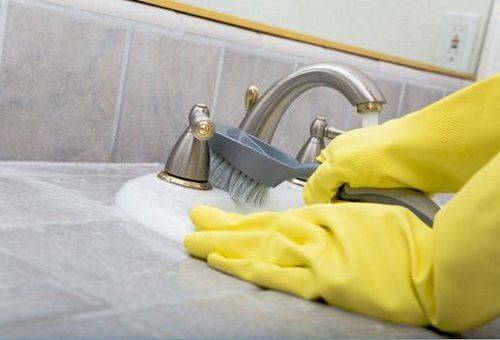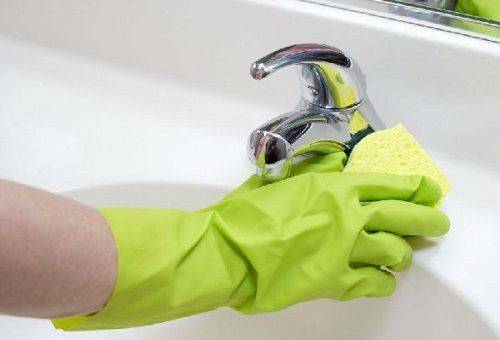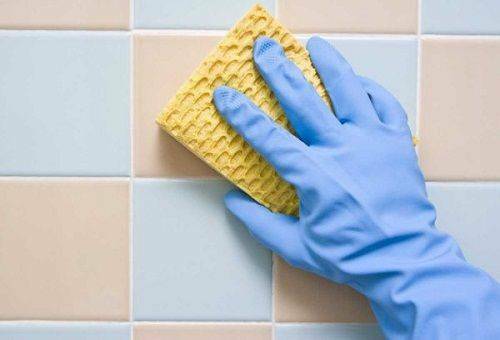Contents:
- How to quickly clean a lime scale from a tap and shower?
- Rules for cleaning tiles, sinks and bathtubs
- How and how can I remove limescale from a plastic surface?
- Than it is safe to wash the lime coating from the glass?
Mineral salts, which are contained in tap water, cause the formation of a dense lime scale on all surfaces of the bathroom. Today there are a lot of drugs designed specifically for its removal, but many housewives prefer to use the old fashioned ways to use household funds.

If you choose the right ingredients, you can not worry about preserving the smoothness and uniformity of the material being processed. Ready-made formulations based on aggressive chemical reagents, although they are less troublesome, can scratch glassware or ceramics, stain the mixer, remove the protective enamel that covers the tap, and eat plastic.
How to quickly clean a lime deposit from a tap and shower?
When dealing with the handling of a faucet, faucet and shower head, you must act cautiously. First, to remove plaque is to try the most gentle means - hot water. On the selected element you need to send a jet of boiling water or hot steam. The tap and shower head are best unscrewed and temporarily put in a container of hot water, while not recommended to add even the most gentle cleanser. After a few minutes, the lime layer begins to soften, it can be easily washed by hand.

Advice: It is strictly forbidden to use as a container for soaking a sink or bath. Such hot water can adversely affect the condition of the coating, especially if the element is made of acrylic.
If you can not clean the nozzle, mixer or tap with high temperatures, you will have to use acetic acid. Begin with a weak solution of white vinegar, if necessary, gradually increase the concentration of the composition. On the mixer or tap, the resulting product should be simply applied, abundantly moistening those areas where a more dense layer of plaque. We are waiting for half an hour, update the staff and wait as much. Then, using a soft sponge, we clean the calcareous outgrowth. Detachable elements, for example, a spray from the shower, it is better to soak in the finished composition.

If the problem is so severe that you had to remove the faucet, faucet and other elements, then it is best to refuse attempts to clean them mechanically. This can damage the thread and cause the plumbing.
Cleaning of tiles, sinks and baths
When cleaning the bathroom in general, the main effort is to apply to remove a dense lime layer from the surface of the bath, sink and tile. There are many effective approaches, but to get the maximum positive result it is recommended to use the following:

- To quickly wash the ceramic tile, spray 6% vinegar on the contaminated area with a spray gun, wait a few minutes and remove the softened brush with a soft brush or a dense sponge.
- Vinegar will help to restore and heavily soiled shell. A glass of 6% of the product is heated to a very warm state and poured into the sink, pre-plugging the drain with a cork. If the lime layer remains not completely covered, prepare a little more composition. We leave everything for the night, and in the morning we drain the remedy and it remains only to clear the remnants of the contamination. Similarly, you can handle the toilet and bath.
- To remove stains that often cover the sink at the crane attachment point, it is recommended to use citric acid. The agent in dry form is applied to a damp sponge and gently three pre-moistened contaminated surfaces, remembering to process the tap and mixer.

Application of these formulations gives a double positive effect - it allows high-quality cleaning of tile, bath, toilet bowl and sink, while eliminating the unpleasant smells characteristic of the bathroom.
Than and how can I remove limescale from a plastic surface?
When working with plastic bathroom elements, the following rules must be observed:
- To remove non-serious deposits of lime type, you need a concentrated soap solution. The finished composition is applied directly to the accumulation sites of the plaque, wait a quarter of an hour and try to wash the formulations with a soft cloth.
- More resistant growths will have to be treated with acid-based products. We make a weak solution based on table vinegar or citric acid, we moisten a rag in it and wipe the problem areas. Do not soak plastic with an aggressive compound, this can lead to material damage.

If it is necessary to clean the plastic elements surrounding the sink, it is better to use ready-made compounds in the form of a cream or paste. These items are constantly exposed to steam, so the raid here is more dense and resistant. If you do not want to resort to the use of dubious chemicals, then you need to process these areas daily using the soap composition at the end of the day.
Than it is safe to wash the lime coating from the glass?

The process of glass cleaning has its own specifics. In spite of the fact that special heavy-duty material is usually used to decorate the bathroom, its abrasive treatment is prohibited.
Even the softest abrasive can cause scratches on the surface, which can not be removed.
It is best to use a solution of a liquid detergent or other detergent in the form of a gel in which a little vinegar is added. Persistent dirt on the surface of the glass can be cleaned with citric acid( a teaspoon per glass of water), but first you need to achieve its complete dissolution.



